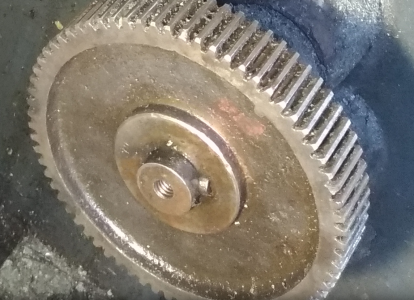Great idea, but unfortunately there are a few other complications......
The math itself is not difficult, it's really just a string of fractions with "driving gear tooth count" on top (numerator) and the "driven gear tooth count" on the bottom (denominator).
The complications are:
1) how many intermediate gears? Without knowing the size and shape of the original banjo it's hard to guess the number of terms in the equation. Should the formula include 3 fractions? or 4 or 5? Some banjos are Y-shaped with slot for multiple gear axles.
2) down-stream gear box: you posted above a picture of a lathe identical to yours. It has a gear box with feed-change levers.
This will end-up being a "black box" on the output of your calculations. However, since you own this lathe you can look inside and count teeth on every gear. I did that on my lathes, really just to understand everything about them. I wiped off the gear and used a paint pen to mark the tooth where I started counting. This required a flashlight and mirror as well, to look thru the open bottom of my quick-change gear box (Southbend 9"). Of course I had the advantage of being able to verify them in a manual.
3) lead screw: Your picture shows that the lead screw looks very close to 4 tpi, but if this lathe was made in Spain, then it likely is metric, and
@T Bredehoft may be correct that it is in fact 6mm. Knowing this is required to work out how far the carriage moves linearly for each rotation of the lead-screw. Perhaps a screw thread gauge can help you to tell the difference.
4) gears that are pinned together need to be calculated a little differently. These may appear as two gears with key ways that together run on a small bushing also with a key. With a pinned pair of gears the "input" gear is only a driven gear NOT a driving gear, therefore its tooth count appears only in a denominator. Similarly, the "output" gear of the pinned pair is only a driving gear and so its tooth count appears only in a numerator.
5) gear spacing; what is there physically room for? for the given gear module (or diametral pitch), can you fit a 50 tooth gear, 64 tooth? 84 tooth?
It is hard to know what options we are allowed to plug into the equation.
Please know that I am NOT trying to discourage you!!!
You CAN figure this out and we will
always try to help!
One other idea is to look at other lathe manuals for a "similar" arrangement. Look for one that also has a 25-tooth gear on the spindle and the same lead-screw pitch; you might be able to use those threading/feed charts exactly as they are (depending on what gears fit your banjo). But also look for any others with a 50-tooth gear on the spindle....that would just require a driven gear with twice the teeth later in the gear chain.
Please don't give up. That looks like an amazing lathe.
-brino



